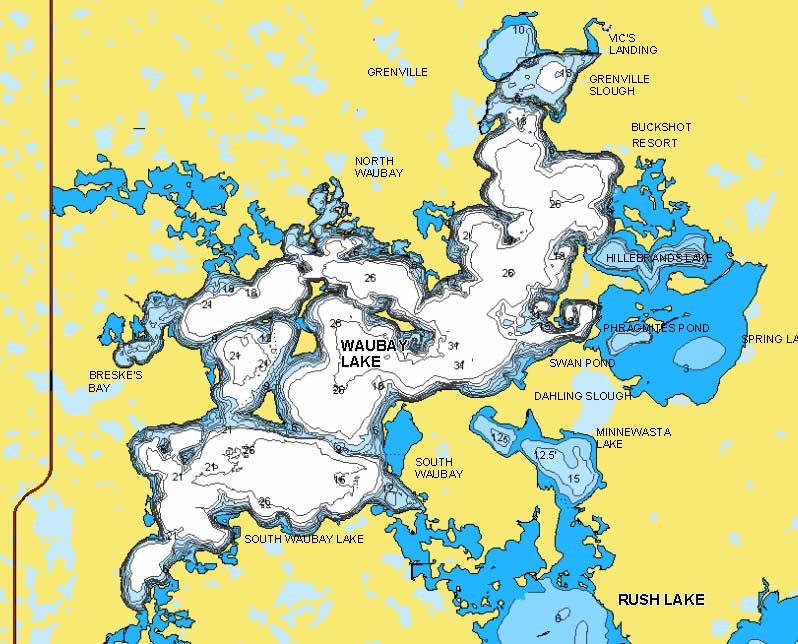
This body of water in Day County, South Dakota, formed in the mid-1990s when rising water levels joined North and South Waubay lakes, Spring Lake and Hillebrands Lake. Since then it’s built a reputation for consistently producing walleyes up to 16 inches, though larger fish are caught occasionally.
Other gamefish, such as smallmouth bass and northern pike, also inhabit Waubay Lake, but their populations are not nearly as large as that of the walleye. As well, there are fishable numbers of yellow perch, which are mainly targeted by ice fishermen.
Walleyes reign supreme on Waubay, and according to Cory Ewing, Northland friend and owner of Waubay Lake Guide Service, anglers need only a few tools to catch them—namely, a good supply of jigs and some spinner rigs.
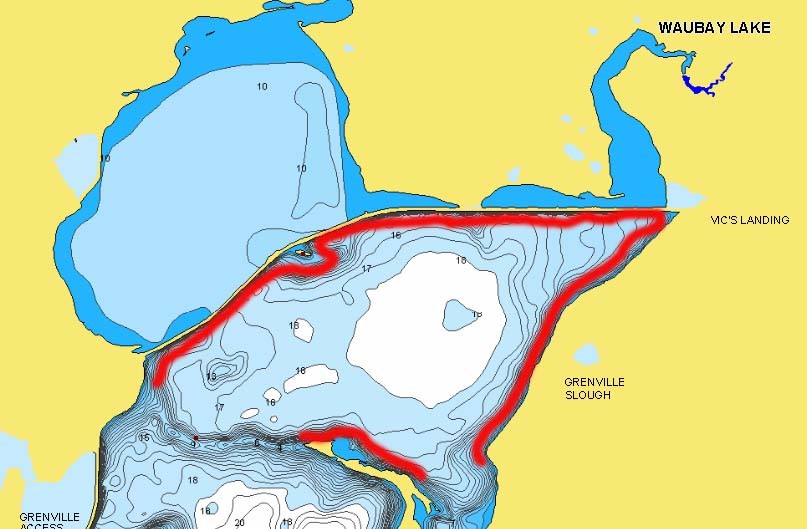
1. Walleyes are fair game year-round in South Dakota, so anglers begin launching boats as soon as the ice cover disappears, which, depending on the year, could happen in April or early May. “The water is super clear and the fish will be extremely shallow,” he says, “keep things quiet and make long casts so you’re fishing away from the boat.”
Back bays where the water warms up first are prime spots early in the spring, and Grenville Slough in the lake’s northeast quadrant is among them, according to the angler. “The two-mile roadbed that runs across the north side is nothing but rock, gravel, and sand,” he says. “So is nearly the entire eastern shoreline. It’s good spawning habitat for walleyes coming out of deep water.”
Ewing recommends pitching a 1/8-ounce Gum-Ball Jig tipped with a live fathead minnow right up to the shoreline, or dragging a minnow-tipped Fire-Ball Jig along the base. “During prime low-light hours in the morning or evening, walleyes could be in just 6 inches of water,” he says. “Sometimes they’re so shallow you can see their backs. As the sun rises, they tend to back out a bit, but they still can be in just 2 to 4 feet of water.”
Walleyes tend to concentrate in spots along the roadbed and shoreline and are easily spooked in the super shallow water. The angler suggests making long casts—parallel to the structure when the wind allows—to cover water and to keep the boat from blowing them out.
“I use a 7-foot, medium-power, fast-action spinning rod, which lets me throw a small jig on a light braided line and short fluorocarbon leader a long way,” he explains. “Because yellow perch are the walleyes’ primary forage, I typically stick with firetiger pattern jigs, but anything with orange, yellow, green, or black is a good choice, too.”
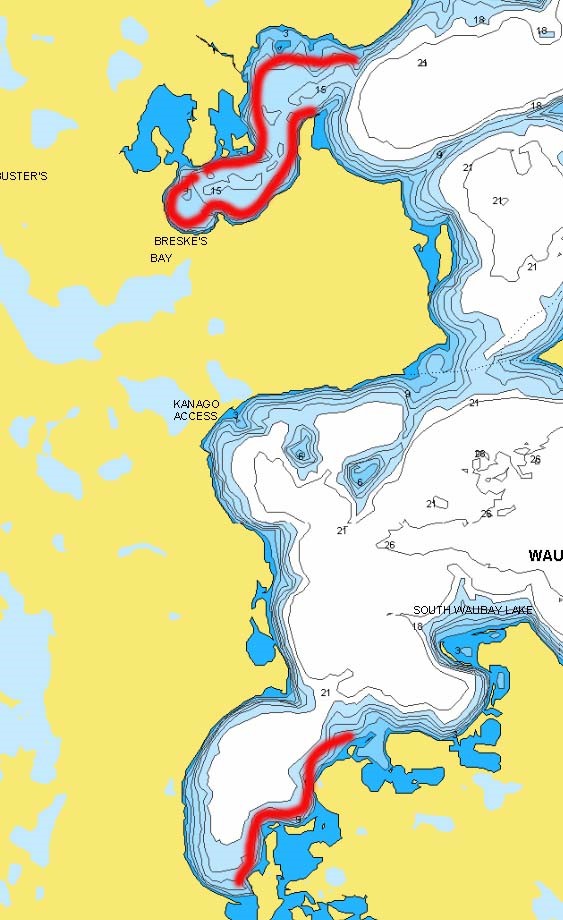
While Grenville Slough is a popular and productive spot for early-season walleyes, it’s not the only one. Ewing suggests anglers try the tactics already mentioned along the shorelines of Breske’s Bay on the Waubay’s west end, as well as along the eastern shore of the lake’s southwestern-most bay.
A jig-and-minnow combo is the best choice throughout the very early period, but when water temps hit a consistent 50 degrees, Ewing switches to soft plastics. “During the late spring you can fish more aggressively with a straight swimming retrieve,” he says. “I favor a ¼-ounce Mimic Minnow Shad in firetiger or perch patterns, but you could also try a 3-inch Eye-Candy Minnow on a Smeltinator Jig. For the most part, you want to cover the same areas, and walleye will usually be 5 feet or shallower, so it’s pretty much a simple cast-and-retrieve presentation.”
Rather than searching for spot-on-the-spot areas where pods of walleyes are congregated as you would with a jig-and-minnow, he adds, fish down an entire shoreline as walleyes will be more scattered now.
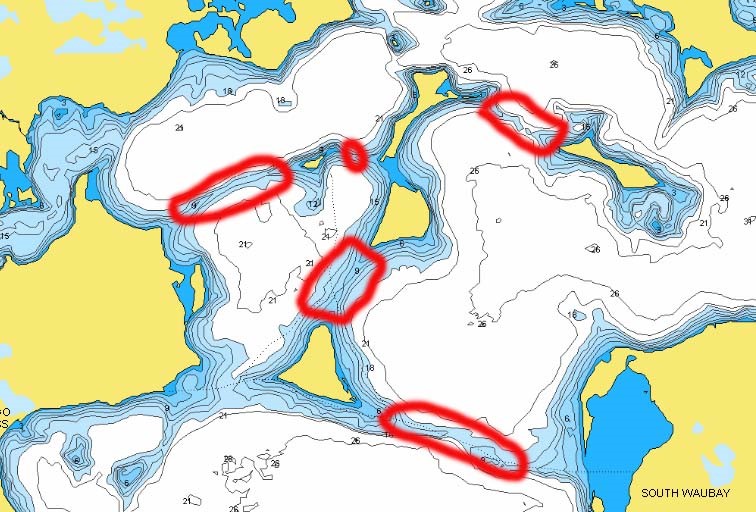
2. The late-spring shallow shoreline bite typically holds until the end of May, but when June rolls around the fish move deeper and head toward the offshore structure. “Once you get into June, it’s pretty much the summer pattern that holds until August,” says Ewing. “One of the most consistent offshore spots is the old roadbed running from the western shoreline to a small island.”
The angler recommends trolling a minnow-tipped Baitfish Spinner Rig or a nightcrawler on a Walleye Crawler Hauler behind a 1-ounce Rock-Runner® Bottom Bouncer along its length. “It gets fairly shallow at either end, but once you’re 100 yards or so from shore there’s not much to worry about,” he says. “Walleyes could be right on top, or off to the sides, but it’s steep and narrow and you can cover all depths in a pass or two.”
A second sunken roadbed between two islands is another summer area. “This one is wider and tapers slowly, so it may take 4 or 5 passes on either side to figure out where the fish are,” he says. “Really, all the bars in that island system, including the saddle that runs to the shoreline to the southeast shoreline are great summertime rigging spots. Figuring out the depth walleyes are holding, and determining the best trolling speed and blade size are all things an angler has to do on a day-to-day basis.”
Come August walleye fishing gets a bit tough, according to the angler, as most fish tend to move to the main basins. “Some anglers don’t even fish Waubay in the late summer,” he says, “but those who do usually troll minnow-body stickbaits on lead-core line. There are some humps and points that walleyes will relate to, but a lot of the time you’re just cruising around looking for suspended fish.”
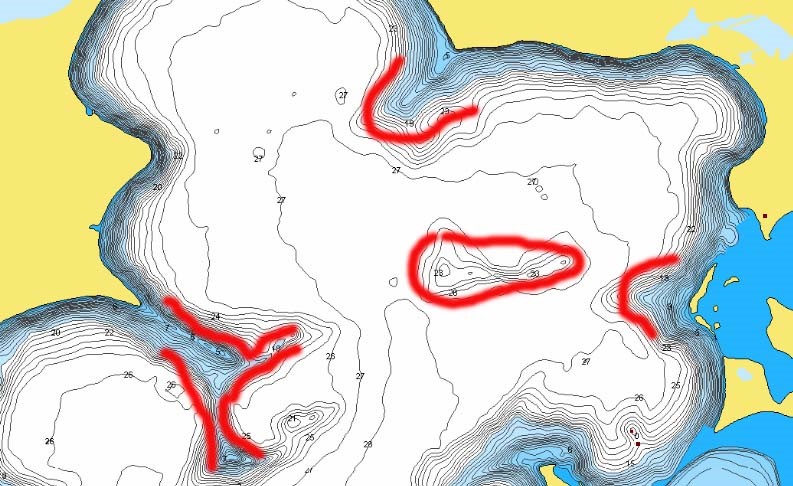
3. By late September, however, the fish have usually moved back to predictable locations. “Now it’s time to focus on main-lake points and underwater humps—places where there’s deep water close to the structure.”
While there are a number of spots that hold fall walleyes on Waubay, Ewing says the northeast section of the primary basin is a good place to start. “There’s an hour-glass-shaped hump, locally known as Flag Hill, which is surrounded by large shoreline points. Any one of those spots will be a good place to find fish.”
He recommends vertically fishing a 1/8- to ¼-ounce Fire-Ball® or Fire-Ball® Spin jig-and-minnow, or a 1/8-ounce Buck-Shot® Rattle Spoon or Forage Minnow® Spoon tipped with a minnow head after locating walleyes with sonar gear.
“Often we’ll spend more time motoring around looking for fish than we do actually fishing,” he explains. “If the walleye are a foot or two off the bottom, you can work the jig fairly aggressively; if they’re laying on the bottom, drop the jig all the way down then lift it about 6 inches and let it sit. Every so often you can re-locate the bottom with the jig and lift it again, but don’t overdo it.”
Ewing fishes this pattern right up until ice-up forces boats off the water, but he says there have been a number of years when he’s traveled back to the very same spots via 4-wheel ATV within a week. “I always start ice fishing where I last caught walleyes out of my boat,” he says. “They don’t move much just because ice has formed on the surface.”
He recommends sticking with the jigging spoons mentioned previously, but tip each hook point with 2 or 3 maggots. “Just as before, look for walleyes with sonar before you start fishing,” he adds.
A week or so after first-ice, though, Waubay’s walleyes tend to move into bays adjacent to the structure they just left. “I’m not sure why it happens,” says Ewing, “but you can pretty much count on it every year.”
Stay with the jigging spoons and maggots, and check along the shorelines in 12 to 14 feet of water, moving shallower or deeper to locate fish if necessary. The entire “early ice” season typically lasts about a month; then most walleyes transition to the deep central basins.
“You can still catch a bunch of fish,” says the guide, “but it usually requires a lot of moving and looking. It just depends on how badly you want them. You just have to keep punching holes until you find signs of life.”
Lake maps courtesy of Navionics. For more information, visit: Navionics.com
Vital Stats
Waubay Lake
Surface Area: 12,841 acres
Maximum Depth: 32 feet
Average Depth: 13 feet
Species Present: Walleyes, Smallmouth Bass, Yellow Perch, Northern Pike, Black Crappies, White Bass, Bluegills, Rock Bass, Lake Herring, Common Carp, Black Bullheads, White Suckers, Spottail Shiners.

